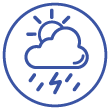Coasts and oceans
Key Messages
-
Increasing ocean temperatures in the Coral Sea is affecting the intensity of cyclones both in terms of maximum wind speeds and in the intensity of rainfall that occurs in association with the cyclone. As cyclones draw energy from the surface waters of the ocean, and as more heat is stored in these upper waters, they have a larger source of energy on which to draw. As climate change is causing sea levels to rise, there is increasing potential for these cyclones to drive more devastating coastal flooding during storm surges.
-
Sea surface temperatures around Queensland (particularly in the Coral Sea, but also in the Gulf of Carpentaria) provide an indicator of the likelihood of the formation and development of tropical cyclones and east coast lows. Warmer than average sea surface temperatures favour the development of these weather systems which often bring flood-producing rainfall, and damaging wind and storm surges, particularly to coastal and near-coastal parts of Queensland. While recent change in mean sea level is not significant, sea level rise over the historical tide gauge record is discernible.
-
Coastal hazards impact on both the natural environment and human settlements. Coastal erosion and storm tide inundation are part of normal coastal processes, albeit at the extreme end of natural fluctuations. For the natural environment, they are the high energy drivers of endless change which has formed the coast we see today. For human settlement however, we consider them destructive and a risk to life and property. Understanding the risks can improve decision-making for both management of the natural environment and new urban development, and help build resilience for existing developments exposed to these hazards.
State
- Sea surface temperature
Sea surface temperatures in the Coral Sea and around northern Australia are about +1oC warmer on average than 100 years ago, with the years 2009 through 2018 being the warmest 10-year period on record.
- Southern Oscillation Index
A strong El Niño occurred from mid-2015 to early 2016, followed by predominantly ENSO-neutral conditions.
- Cyclone activity
Queensland experienced 8 cyclones between 1 January 2018 and 1 April 2020.
- Sea level
Queensland’s sea levels are rising according to historical tide gauge records.
- Storm tide inundation incidences
Storm tide inundations continue to impact the coast.
Pressure
- Coastal hazard erosion prone area
Coastal erosion continues to impact the Queensland coast, with several major incidents at developed areas.
Resources
| Sea Surface Temperature monitoring | Sea Surface Temperature (SST) time series are available from 1900 for a number of regions around Australia. These time series include ocean surface temperatures only and do not include any land surface temperatures. The sea surface temperature information for the Coral Sea (4°S–26°S, 142°E–174°E) and Northern Tropics (4°S–22°S, 94°E–174°E) regions are based on data from 1900 to 2017 and differences from the 1961–1990 average. |
| Southern Oscillation Index monitoring | The Southern Oscillation Index (SOI) is a widely used atmospheric indicator of the El Niño-Southern Oscillation (ENSO). SOI information is based on monthly SOI data from 1875 to 2017, calculated using an 1887 to 1989 base period. The SOI data are from the Queensland Government Long Paddock website and are calculated using Darwin and Tahiti daily mean sea level pressures sourced from the Bureau of Meteorology and Météo France, respectively. |
| Cyclone monitoring | The Bureau of Meteorology provides real time threat assessment, tracking and historical information on cyclone events. |
| Tide monitoring | Maritime Safety Queensland, Queensland port authorities, the Department of Environment and Science and the Australian Maritime Safety Authority jointly operate tide gauge networks around the Queensland coast. |
| Storm tide monitoring | A network of 25 storm tide monitoring sites along the Queensland coastline allows for recording water levels these events and real-time access to sea level data during the event. |
| Sea level monitoring | The Australian Baseline Sea Level Monitoring Project is designed to monitor sea level around the coastline of Australia. The Permanent Service for Mean Sea Level (PSMSL) is the global data bank for long term sea level change information from tide gauges and bottom pressure recorders. |
| Wave monitoring | A network of wave monitoring buoys measure the height and direction of waves along the Queensland coast. |
| Erosion prone area mapping | The Department of Environment and Science prepares erosion prone area plans showing the width of the coast that is considered vulnerable to coastal erosion and tidal inundation and indicative footprint mapping of this area. Spatial information files showing the indicative erosion prone area can be accessed from Queensland Spatial Catalogue (Qspatial). |



